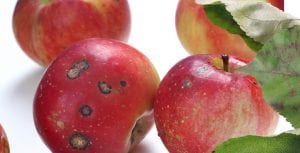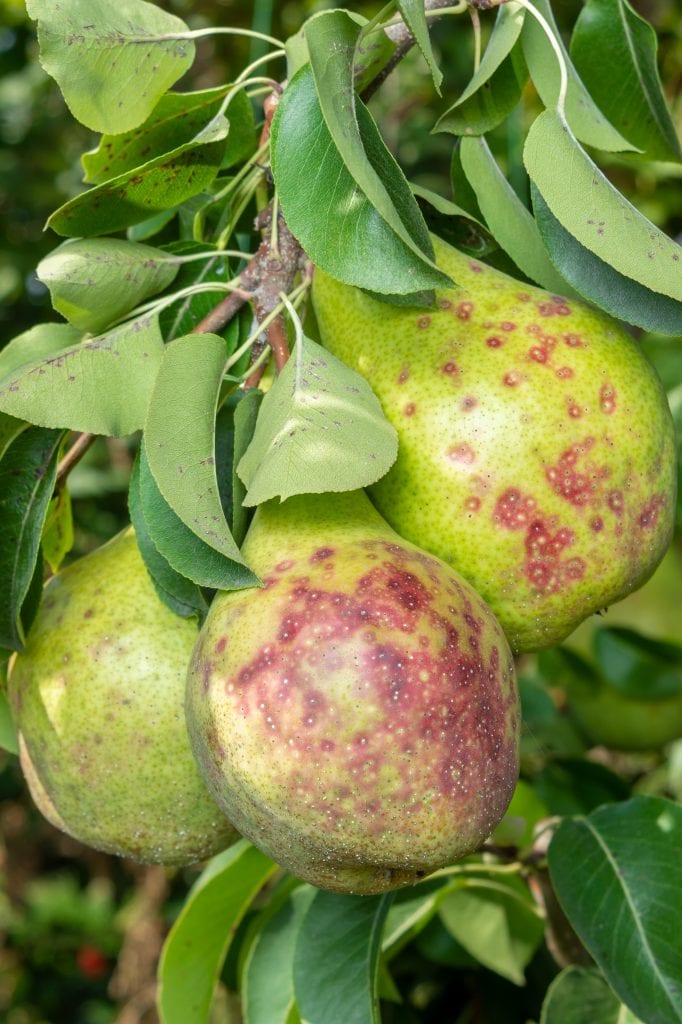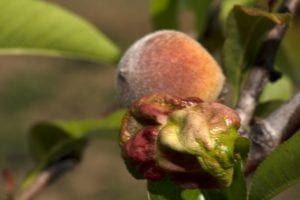Keep Your Fruit Trees Healthy: Identifying Diseases and Solutions
Prevent apple scab, rusts, peach curl & more with proper fungicide for fruit trees! Summer brings a bounty of activities, including extra work in the yard and landscape — especially for those with an annual vegetable garden or as perennial fruiting plants and trees enter their growing season. But as the temperatures begin to rise, fungal fruit tree diseases begin to make themselves known on all types of fruit trees including crabapple, pear, apple and peach. Taking care of your plants and trees is our number one priority at Ryan Lawn & Tree. There are a few common diseases that we deal with here in the Midwest, and knowing what symptoms to look for can help you determine how to prevent fruit tree diseases and take the steps you need to take to keep your trees healthy.
Apple Scab Disease

Apple scab can cause brown spots and lesions to form on the leaves and fruits of apple and crabapple trees.
This disease affects the leaves and fruits of both crabapple and apple trees, caused by the fungus Venturia inaequalis. In the late spring and early summer, it causes brown spots and lesions to form on the leaves and fruits of these types of trees. It can be especially bad in very wet springs where the rainfall is frequent and the night temperatures stay cool. The best method to control and prevent this disease from damaging your trees is to spray fungicides for these fruit trees at regular intervals of two to three weeks during the period when disease pressure is the highest and the conditions are right for the fungus to develop and spread. In the Midwest area that is usually from when they first leaf out in March, through the end of May.
Rust Diseases

Rust disease is shown on pear tree leaves and fruits close up. Ryan Lawn & Tree can help protect your fruit trees against fungus.
While cedar-apple rust is the most common and well-known of the rust diseases, there are several others that can plague your trees. Fortunately, they all have similar enough symptoms and the same method for controlling and preventing them that they can all be lumped into one category.
The cedar-apple rust, caused by the fungus Gymnosporangium juniper-virginianae, is most notable for the bright orange and brown galls that it causes on junipers and native cedars. These can be seen in mid-spring as they release their spores, which float through the air to land on their second host, your apple, crabapple or hawthorn trees.
There is also a similar fungus that causes the same symptoms on pear trees. As the rust diseases begin to develop on the leaves, small, pale yellow spots will begin to appear. They continue to grow and turn into bright orange spots and lesions that are later accompanied by small black dots that begin to cover the leaves. If the infestation is heavy enough, the leaves will begin to fall from the tree, causing light to moderate defoliation. Left untreated for several seasons, this will slowly weaken the tree.
The best method to control rust diseases is very similar to the control of apple scab. Regular fungicide applications during the same window of heavy disease pressure will keep your fruit trees happy and fungus-free.
Peach Leaf Curl Disease
This disease is caused by the fungus Taphrina deformans. It is a very tricky disease that in heavy infestations can cause serious defoliation, fruit deformities and loss of tree vigor. Fortunately, in most cases, you will likely only see small amounts of this disease that disappear as we reach the high temperatures of summer.
The first symptoms show up about three to four weeks after the tree blooms, depending on the weather. The leaves will become red and contorted, curling and thickening, making them appear as if they have a bad case of poison ivy.
Eventually, these infected leaves will turn brown and drop off. For many, this will be as bad as it gets.
However, some peach trees are more susceptible. In those cases, the symptoms may persist on the tree for a month or more, spreading to more leaves and even infecting the fruits with the same red and bumpy “rash.” Those severe infections will require treatment. The only bad news is that by the time symptoms appear, it is absolutely too late to do anything about it.
Peach leaf curl can only be mildly treated with a copper fungicide spray in fall after the leaves drop, or in very early spring before bud break (some cases may need both sprays). Even with the sprays, it is a tricky disease and it is very normal to still see some symptoms after treatment. So even though it is too late to spray for this season, now you can be prepared to take care of it for next season.
Proper Fungicide for Trees
There are two pillars to consider when treating your fruit trees: using the proper fungicide and using it at the proper time. While there are many different fungicides on the market to control fungal diseases in trees, there aren’t as many that are labeled for fruit trees. You have to be careful when spraying any tree that will have fruit that is planned for consumption. The aforementioned fungal diseases are usually controlled by fungicides containing myclobutanil as the active ingredient, or a copper-based active ingredient, but always read the label first to be sure the product you use will control the specific fungus you are battling.
Be sure to read the label and use the proper mix rates to be sure only the correct amount of chemical gets sprayed on the trees, and always be sure to observe a proper withdrawal period, only harvesting the fruit after the labeled number of days. Using the chemicals properly will ensure that you can safely enjoy the bountiful harvest of fruit from your trees.
Proper Timing For Fungicide
The best thing to remember about the perfect timing for fungal diseases is that prevention is the best medicine. Most fungal diseases are best controlled if the first spray is timed to when the trees first leaf out. Fungicides act as a preventative, protecting the young leaves from the invading fungi. This means that they don’t always provide as many curative benefits.
However, if symptoms are mild, and it isn’t too late in the season, fungicides for fruit trees can still help lessen the symptoms. Worst case, you are now able to identify which fungus is attacking your trees, know how to prevent the problem next season, and you can continue to enjoy growing and eating your own fruit from your healthy trees.
Call Ryan Lawn & Tree For Fruit Tree Fungicide Treatments Today!
Don’t wait until it’s too late to treat your fruit trees with the proper dose of fungicide for fruit trees. Request a free quote or give our RYAN Pro a call today at 855.216.2293 and schedule an inspection of to see if your fruit trees have any of these common fungal diseases. At Ryan Lawn & Tree, we go the extra mile to ensure your lawn and trees are properly cared for and thriving.










